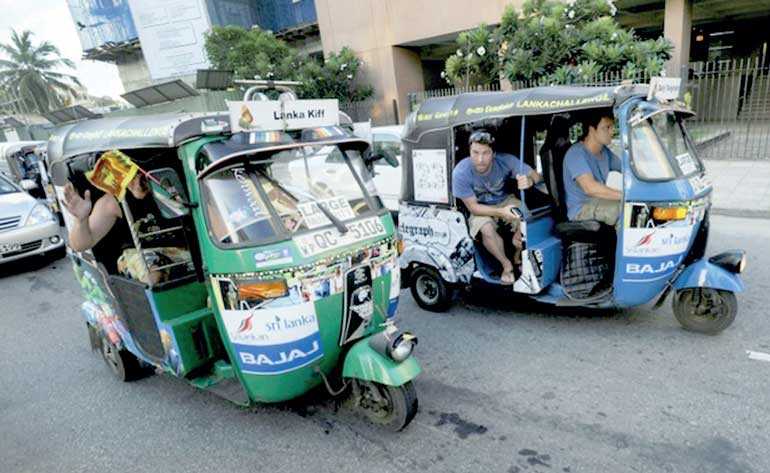Wednesday Jan 07, 2026
Wednesday Jan 07, 2026
Wednesday, 1 August 2018 00:00 - - {{hitsCtrl.values.hits}}



By Dhananath Fernando
I live in Moratuwa, down Diggala Road, a 2 km byroad from Keselwaata Junction on the Old Galle Road. In my little hamlet there are only two mini Lanka Ashok Leyland buses that operate in synchronisation with the train time table from the Moratuwa Railway Station to Diggala Road. Regardless of this inefficient bus operation, my saviours are an efficient and unique operation of tuk-tuks that cover a 2 km radius from the railway station, enabling the commuting needs of the neighbourhood.
Mapping out the
tuk-tuk operation
In terms of the cost, the three-wheelers engaged in this operation on this route only charge a ‘per passenger’ rate instead of a ‘per km’ rate or a standard hire fare like almost all other tuk-tuks in the country. This means that each person has to only pay a fare of Rs. 20 (despite the distance) and they take three passengers at a time in a single tuk. In simple words, it is a three-passenger bus system operating at 10-minute intervals. Their services are available until about 11.00 p.m. and I am very grateful to all the drivers operating their three-wheelers along the route and for providing us daily commuters with such an honourable and sustainable service.
You could even call me an over-satisfied customer as the journey is more comfortable than the bus in many aspects. Seating, availability, frequency, reliability and ability to get off the vehicle right near the gate of my house are just a few advantages of this service. All this is just Rs. 5 higher than the bus fare, which is unreliable and mostly unavailable.
This is one of the many services rendered by tuk-tuks that fail to reach mainstream newspaper headlines. This is why I am worried about the adverse impacts that would overcome the industry when strict regulations are imposed by the National Council for Road Safety which plans to regulate three-wheelers to have a metre and print bills starting from 1 August 2018. On the surface it looks like a step in the right direction as it seems to protect a consumer using this service but in a practical world there would be many unintended consequences. Let’s analyse how these regulations would affect the tuk-tuk service in my area.
The adverse impact of regulations on
tuk-tuks
If the tuks in my area were to adhere to new regulations and introduce a metre and a printed bill, they would no longer be able to charge a per passenger rate. Instead they have to charge a fare as per the standard metre rate. This results in someone like me, who initially only paid Rs. 20 for a one-way fare from the railway station to my house, now paying up to Rs. 60 a ride, a price hike of 300%. Personally, I don’t think that I should bare this extra cost for the sake of receiving a standard fare rate and a printed bill. Eventually this will result in me limiting my usage of tuk-tuks as a consumer. I know that the demand for tuks in my neighborhood will reduce and this isn’t a phenomena only limited to my area.
There is also a second possible outcome of these regulations. The issue with regulations is the limited capabilities and downfalls of the Government in terms of endorsing them. Most tuk-tuks will continue to operate as they do now, automatically creating a black market supply in tuk-tuk services. I am not arguing against regulations because of the inefficiencies in endorsing them, I am arguing against the case of regulations because regulations are not the best way to achieve the stated objectives: a standardised tuk-tuk fare across the country
Unlocking innovation through competition, not regulation
Most Sri Lankan state institutions and politicians, across all parties, believe that state intervention and regulation is the only solution for public concerns as this. The practicality of regulations and its eventual reality do not agree.
We often forget that the innovations made in the taxi services industry, like telephone call-based taxi services such as Budget Taxi, Fair Taxi or taxi services utilising the use of mobile phone and app technology, such as Pick me, were not a result of regulation or strict control over the industry. These innovations were a result of minimum regulation and the presence of competition in the free market provision of tuk-tuk and taxi services. It was simply the freedom and space to innovate and serve customers and taxi drivers better to meet higher profit targets that drove these businesses to create such innovative solutions in the industry.
The world and markets evolve based on the needs of consumers and there needs to be market freedom to ensure innovative solutions to meet these needs. This is a fundamental in economic theory and not a concept of rocket science or as some may call it a ‘foreign conspiracy’.
Additionally, according to the guidelines of the new regulations, every tuk-tuk must have a meter and should issue a printed receipt to the customer at the end of every ride. Does this mean that the many mobile app taxi services that generally provide an SMS receipt now require to provide a printed bill? When the entire world is going green, why an extra hassle for the driver to print a bill at an extra cost?
As a passenger and consumer there are services I expect a receipt for and there are services for which I do not expect one. If it is a household electronic item, I will definitely demand a receipt for warranty and returns purposes but from a taxi driver I do not expect a receipt. Rather I expect a safe and quick ride to my destination. This is not the first time the current Government has made attempts to regulate tuk-tuks. They imposed a minimum age ceiling of 35 years for tuk-tuk drivers. The justification behind this was apparently because three-wheelers contributed to the most number of road accidents of the recent past. However, as the data in Table 1 shows, this is not the case.
Snapshot of three-wheeler industry
Number of three-wheelers registered in Sri Lanka (2016) – 1,115, 987
Total taxes for a three-wheeler in importing at the border – Rs. 420,00 [Rs. 2,100 per 1cc * 200]
Leave tuk-tuks alone
Three-wheelers are not just a mode of transport. They mean different things to those from different walks of life. For a rural commoner, it is an ambulance in a time of emergency. It is equivalent to a VIP Defender for an office worker, in a rush for his afternoon meeting. It is a wedding vehicle for a poor household. For entrepreneurs in urban and rural parts of the country, it is their mini-lorry and companion. More than everything, it is an aspiration and product of pride for more than one million households in Sri Lanka. A poor man has to shoulder a tax of Rs. 420,000 for a tuk-tuk. This tax is then used to fund loss-making state-owned enterprises, provide for the excess of government sector employees’ salaries and pensions as well as a continuing list of unnecessary provisions.
It is not rare to find tuk-tuks with logos of European cars pasted on their bodies. You see everything from Audi to BMW stickers on some tuk-tuks. This sends a strong message to the rest of society. To a poor man, it is his BMW and his Audi. In other words, it is his aspiration and it is his world. Killing these aspirations with unnecessary regulations is never the solution. Restructuring the service provided through competition and innovation is.